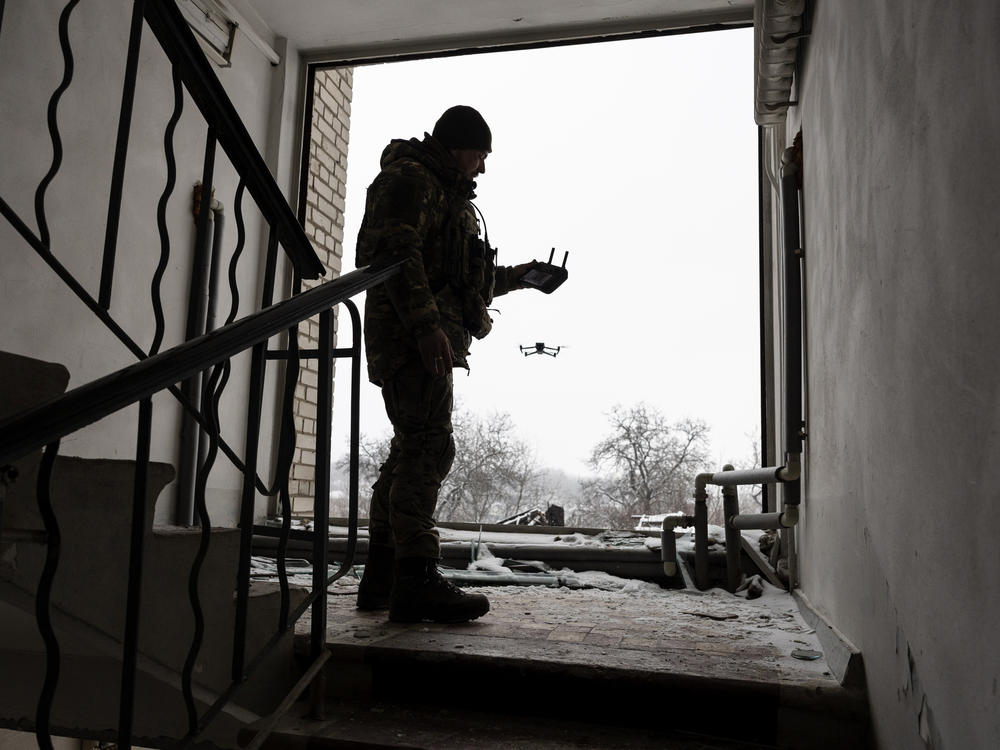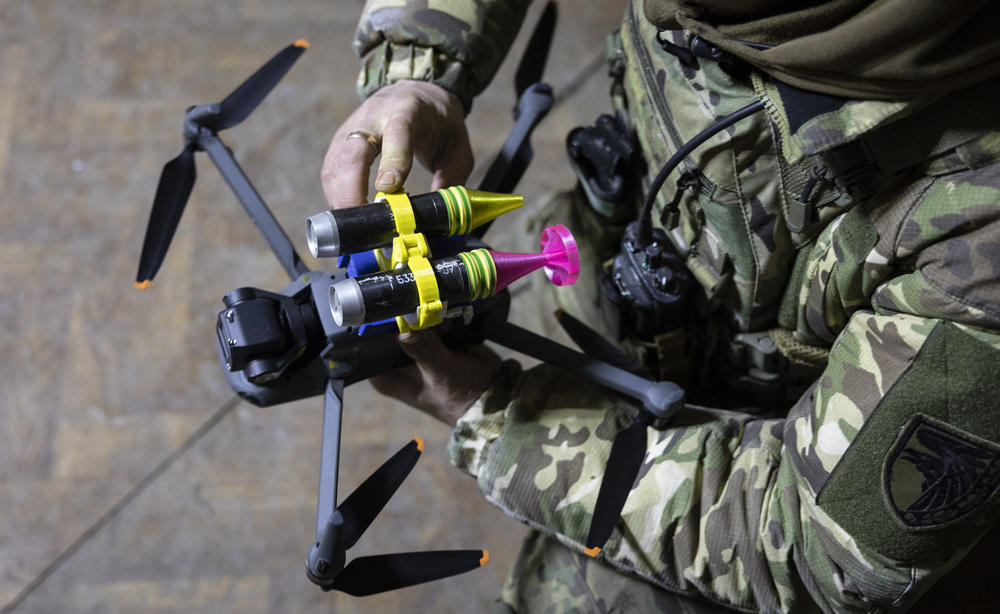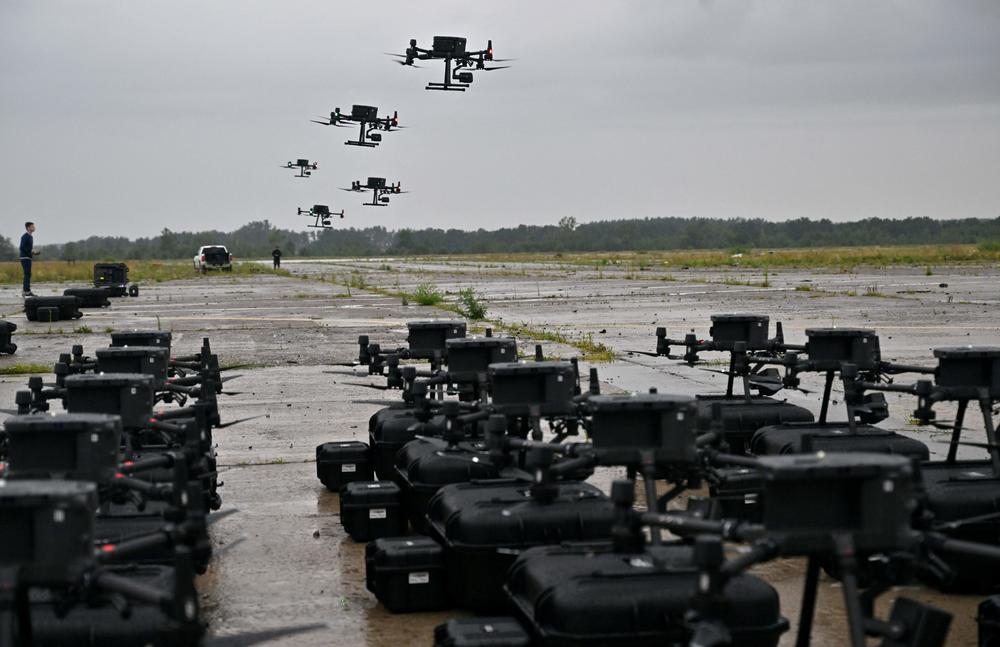Section Branding
Header Content
A Chinese drone for hobbyists plays a crucial role in the Russia-Ukraine war
Primary Content
There's lots of talk about the possibility of China supplying weapons to Russia for its war in Ukraine. But one Chinese product already plays a critical role on the battlefield - DJI commercial drones.
The drones cost around $2,000 or less. They're easy to fly, widely available online and in electronics stores, and are hugely popular worldwide among civilians who fly drones in the park for fun.
They're also a hot commodity for troops on both sides of the Ukraine war.
"Before this war, people mostly used them to play around with things for experimental purposes, like, 'Can I drop a water bottle?' You see these videos on YouTube," said Faine Greenwood, a researcher based in Boston. She's documenting drone use in Ukraine based largely on videos that appear on social media.
"The Ukrainians, and the Russians too, have figured out ways to modify these devices they've purchased online to make more and more creative ways to drop explosives from these small consumer drones," she said.
Greenwood has examined more than 1,000 cases over the past year and can identify the type of drone used in half of them. By far the most popular — for both reconnaissance and for attacks — are the DJI commercial drones made in China. They account for more than half she's been able to identify.
This is happening even though DJI announced in April 2022 that it would stop selling drones to Ukraine or Russia because they were not intended to be used for military activities.
In an email to NPR, DJI said "we have a longstanding prohibition on selling our products for combat use."
"We have seen reports that show how our products are being transported to Russia and Ukraine from other countries, where they can be bought off-the-shelf," the statement added. "Like any consumer electronics company with products sold at many different electronics stores, we cannot influence how all our products are being used once they leave our control."
DJI drones are easy to buy — just check out the many options on Amazon — and are widely considered the world's most popular consumer drones. No other drone maker has been able to match DJI in terms of quality, price, ease-of-use and global distribution, according to Greenwood and others who keep close tabs on the drone market.
"When most Americans think about drone warfare, the image I think that comes to mind is from the global war on terror, which were military grade, sophisticated, expensive capabilities that were used to strike, particularly at high-value targets," said Kelly Grieco, who been following the air war for the Stimson Center in Washington."
The reality is very different in Ukraine, where drones are everywhere and traditional military planes, including fighter jets, are relatively rare.
"What we're seeing is that there's a commercial drone market that has emerged. They're very useful to provide eyes on a battlefield," she said.
DJI drones aren't made to fire weapons. But they can be easily modified to carry a grenade or other small explosive, which can be dropped with great precision into trenches filled with troops, or directly into the open top of a tank.
Ukrainian troops began using these drones early on, and post videos of the attacks daily on Twitter, Telegram and other social media sites. In turn, these videos help Ukrainian aid groups raise money — to buy more drones.
"Ukraine's been very successful in creating a strategic narrative to really keep Western support going," said Grieco. "Part of that is showing that it's a viable adversary, that they have spunk, and a lot of that gets communicated with these drone videos."
At the start of the war, Russia tried — and failed — to establish air superiority with its fighter jets. Now it's turned to a cheaper option.
Russia uses Iranian-made Shahed military drones to carry out attacks, and often turns to DJI drones for surveillance.
While DJI drones are constantly in the skies over Ukraine, they do have limitations, mostly linked to the life of their batteries.
They only travel about five miles. They stay aloft for less than an hour. They can only carry a light explosive, like a grenade. And they are vulnerable to enemy attack, said Andrey Liscovich, who heads the Ukraine Defense Fund, a private group helping the military.
"The downside of these drones is that they can be shot out of the sky with rifles," said Liscovich. "When they do these weapons drops, they're not very high, maybe 70 to 100 meters. At that range, you can use an AK-47 to hit it if you are a decent shot."
Liscovich was born in Ukraine. He has a doctorate from Harvard and was an executive at Uber in California. When Russia invaded last year, he dropped everything to form his group.
He's working with Western tech companies to develop drones that can fly further and stay aloft longer. The goal is a real-time view of the battlefield for longer-range Ukrainian artillery fired at Russian positions.
Another big challenge is to develop systems that can't be jammed electronically by Russia, says Liscovich, who spoke to NPR by phone from the eastern city of Zaporizhizhia.
"So we need to constantly play this arms race game with the enemy," he said.
Still, drones are already doing things hard to imagine — until they happen.
Recently, a Russian fighter surrendered to a Ukrainian drone, which filmed the capitulation. The Ukrainians posted the video, along with instructions on how other Russians could do the same. It's part of a project they call "I Want to Live."
Greg Myre is an NPR national security correspondent. Follow him @gregmyre1.
Copyright 2023 NPR. To see more, visit https://www.npr.org.



